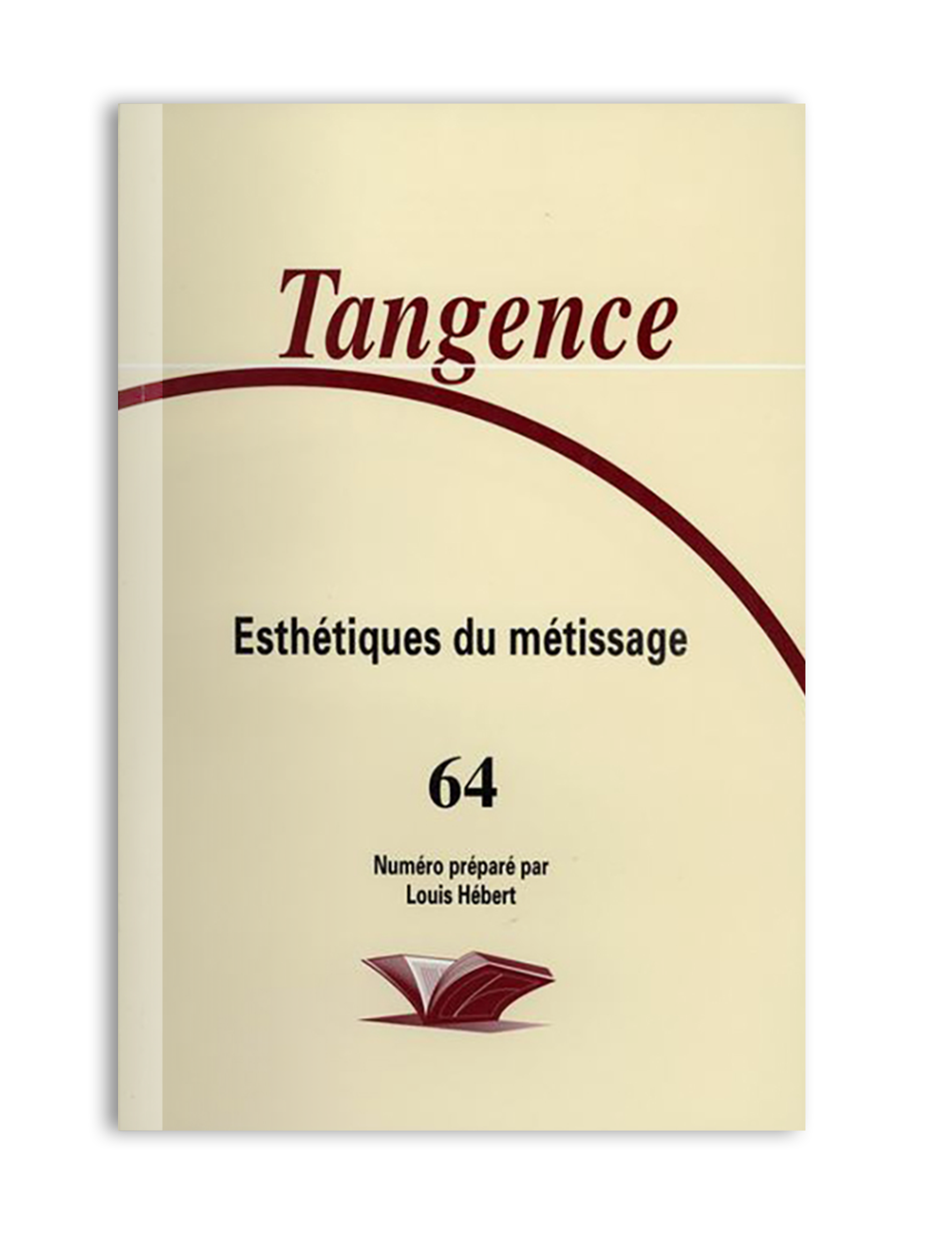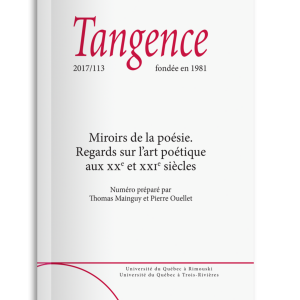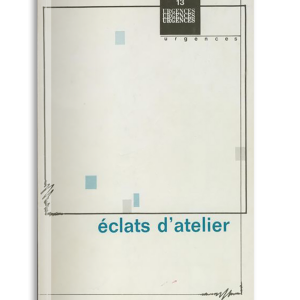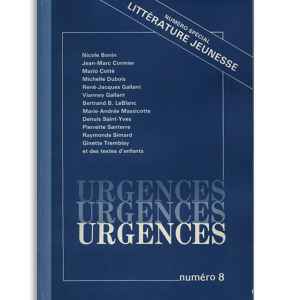N° 64, automne 2000
Esthétiques du métissage
Claude Zilberberg
Les contraintes sémiotiques du métissage
Cette étude traite du métissage en lui prêtant d’emblée une signification étendue. Cette généralisation est propre à l’hypothèse du « schématisme tensif » (Fontanille-Zilberberg), laquelle privilégie deux sortes d’opérations : des augmentations et des diminutions sur la dimension de l’intensité, celle des « états d’âme », des tris et des mélanges sur la dimension de l’extensité, celle des « états de choses ». Ces prémisses conduisent à la mise en évidence de deux illusions : en premier lieu, l’illusion propositionnelle dans la mesure où la proposition s’impose davantage par sa transitivité que par sa suffisance ; en second lieu, l’illusion objectale : l’objet en sa singularité est plutôt un cas que la norme. Le sujet est sollicité, défié par la nécessité ou l’arbitraire des groupements et des collections qui lui sont proposés ou imposés. Dès lors que l’objet est défini par ses latitudes et/ou ses restrictions de circulation, il devient compréhensible que le tempo et la temporalité contrôlent cette circulation tantôt en la ralentissant, tantôt en l’accélérant.
Semiotic constraints of cross-pollination
This study treats of cross-pollination by conferring an extended meaning upon it from the start. This generalization is proper to the hypothesis of “tensive schematization” (Fontanille-Zilberberg) which puts forward two sorts of operation : either augmentation or diminution of the dimension of intensity, that referring to “emotional states”, classifyings and mixings of the dimension of extensity, that referring to “states of things”. These premises lead to the exposure of two illusions : first, the propositional illusion, to the extent that the proposition is more convincing by its transitivity than by its sufficiency ; and second, the objectal illusion — that the object in its singularity is a case rather than the norm. The subject is solicited and defied by necessity or by the arbitrary nature of the groupings and collections proposed or imposed. From this point where the object is defined by its latitudes and/or restrictions of circulation, it becomes understandable that tempo and temporality control this circulation, causing it sometimes to slow down and some-times to speed up.
***
Louis Hébert
Analyse et représentation des topoï. Le topos du poète méprisé
L’article propose, d’abord, une définition et une caractérisation du topos dans le cadre de la sémantique interprétative, où il est assimilé à une structure sémantique socionormée investissant la sous-composante de la thématique appelée topique ; ensuite, un formalisme de représentation des structures sémantiques en général et des topoï en particulier, les graphes sémantiques (inspirés des conceptual graphs de Sowa) ; enfin, une représentation et une étude du topos que nous appellerons « le poète méprisé ». Le graphe-type que nous proposons est en fait une généralisation de ce topos : entre autres modifications, le poète y devient un individu exceptionnel et sa production poétique une transmission positive à la collectivité. Cette généralisation permet de montrer la nature transversale, transhistorique, transculturelle, transdiscursive — bref métissée et métissante — du topos, qui recouvre non seulement des occurrences littéraires (Baudelaire, Hugo, etc.), mais également religieuses (La Bible), philosophiques (Platon), lyriques (Aznavour), etc. L’étude topique envisagée ici consiste à mettre en rapport le topos-type et les divers topoï-occurrence qui le manifestent.
Analysis and representation of the topoï. The topos of the scorned poet
The article proposes first a definition and a characterization of the topos within the framework of interpretive semantics, where it is assimilated to a socio-normed semantic structure comprising the sub-component of the thematic called topic ; then a formalism representing semantic structures in general and topoï in particular, semantic graphs (inspired by the conceptual graphs of Sowa) ; and finally a representation and study of the toposwhich we shall call “the scorned poet”. The graph-type which we are proposing is in fact a generalization of this topos : among other modifications, through it the poet becomes an exceptional individual and his poetic production a positive message to the collectivity. This generalization allows us to show the transversal, transhistoric, transcultural, transdiscursive — in fact cross-pollinated and cross-pollinating — nature of the topos, which covers not only literary (Baudelaire, Hugo, etc.) but also religious (the Bible), philosophical (Plato), and lyrical (Aznavour) occurrences, among others. The topic study envisioned here consists of establishing the relationship between the topos-type and the different topoï-occurence which display it.
***
Claude Le Bœuf
Réflexion sur le métissage de la sémiotique, du marketing et de la science de la communication à propos du statut des produits-signes
Le statut des produits pris comme signes conduit la sémiotique à la rencontre de la science de la communication, disciplines aujourd’hui interpellées par la nouvelle sociologie des sciences et techniques. Le développement des travaux sur les artefacts communicationnels, trop rapidement qualifiés d’« objets intelligents » soutenus par des travaux sur la « cognition distribuée » et l’« action située », invite à reconsidérer la sémiotique des produits et à solliciter en particulier le concept d’interprétant peircien. La perspective renouvelle une réflexion pluridisciplinaire sur le statut des produits (ou marchandises). Elle nous conduit à considérer que les produits, habituellement appréhendés par les spécialistes de marketing comme formes et contenus à la fois (confusion du produit et de son image, lien direct du representamen et de l’objet pour C. Peirce), sont en passe de se transformer en interprétants. Elle affecte en conséquence les rapports entre les disciplines et nous conduit à inverser les relations entre la sémiotique, le marketing et la science de la communication.
Reflection on the cross-pollination of semiotics, marketing and communications science with regard to the status of product/signs
The status of products taken as signs leads semiotics to an encounter with communications science, disciplines currently being called to account by the new sociology of sciences and techniques. Developments in work on communications artefacts, too quickly described as “intelligent objects” supported by work on “distributed cognition” and “situated action”, invite us to take a fresh look at the semiotics of products and in particular to call upon the concept of the Peircian interpretant. This prospect renews a pluridisciplinary reflection on the status of products (or merchandise). It leads us to consider the fact that products, customarily understood by specialists in marketing as both form and content (confusion of the product with its image, for C. Peirce a direct link between the representamen and the object), are in the process of being transformed into interpretants. This affects relations among the disciplines and leads us to reverse the relationship between semiotics, marketing and communications science.
***
Lucie Roy
Réalité-documentaire. « Transductivité » et migrations théoriques
Dans son article, l’auteure cherche à considérer les principes de la « singularité » (toute écriture est, en effet, singulière et l’est toujours et déjà, eu égard au fait que ses supports font naître des images différentes du monde) et de la « transductivité » (par laquelle se reconnaît tout de même l’idée d’une sorte de mutualité de rapports entre monde et écriture : toute écriture se retrouve dans le monde, d’où elle provient peu ou prou, comme tout monde retourne, d’une façon ou d’une autre, à l’écriture, voire en dépend). Le terme « transductivité », qui chez Bernard Stiegler sert à nommer la relation entre l’image mentale et l’image-objet, permet à l’auteure de l’article de considérer l’écriture ou, autrement dit, la réalité du documentaire ; de mettre en jeu les prétendus effets de réalisme que le documentaire le plus pur ou le moins métissé suscite ; de considérer ce que l’on pourrait appeler ici l’hétérogénéité fondatrice de l’écriture ou sa contingence relative, une contingence qui, étant son produit, susciterait des réflexions de l’ordre de l’idé-o-logie.
Documentary reality. “Transductivity” and theoretical migrations
In her article, the author sets out to consider the principles of “singularity” (all writing is in fact singular always has been and always will be, when one remembers that its underlying structures call up different images of the world) and “transductivity” (through which one immediately recognizes the idea of a sort of mutuality of relations between the world and writing : all writing takes place in the world, from which, to a greater or lesser extent, it is derived, just as every world returns, one way or another, to writing, or even depends upon it). The term “transductivity”, which Bernard Stiegler uses to denote the relationship between the mental image and the object image, allows the author of the article to consider the writing or, put another way, the reality of the documentary ; to put into play the so-called effects of realism which the purest — or the least cross-pollinated — documentary calls up ; to consider what might here be described as the founding heterogeneity of writing or its angle of relative contingence, a contingence which, as its product, will give rise to reflections of an ide-o-logical order.
***
Jacques Fontanille et Jean Fisette
Le sensible et les modalités de la semiosis. Pour un métissage théorique [Dossier]
De part et d’autre de l’Atlantique, des problématiques de recherches similaires ont été élaborées, qui prennent pour objet la construction de problématiques sémiotiques à partir des caractères sensibles spécifiques aux diverses perceptions. Une même discipline, la sémiotique, accueille ces recherches qui sont pourtant fondées sur des traditions de savoir fort différentes. Des discussions et des échanges, se situant principalement sur les plans méthodologique et épistémologique, accompagnent donc les propositions de base. On aura donc voulu tenter l’épreuve d’un rapprochement entre des démarches d’appartenance post-greimassienne et post-peircienne. Tel a été et tel demeure l’objectif d’un métissage théorique.
The role of the senses and the modalities of semiosis. For a theoretical cross-pollination [Dossier]
On both sides of the Atlantic, similar research problematics have been developed, which aim to construct semiotic problematics based on characteristics of the senses specific to diverse perceptions. One single discipline, semiotics, takes under its wing all this research founded notwithstanding on very different knowledge traditions. Thus discussions and exchanges, dealing principally with levels of methodology and epistemology, accompany the basic propositions. The intention was to test a rapprochement between post-Greimassian and post-Peircian approaches to belonging. This was and remains the objective of a theoretical cross-pollination.
***
Jean Fisette
Le visible et l’audible : spécificités perceptives, dispositions sémiotiques et pluralité d’avancées sémiosiques
Cette réflexion sur le visible et l’audible repose sur un postulat à l’effet que le sens de la vision génère une image et donc une compréhension du monde qui diffèrent de façon importante et sous de nombreux aspects de la représentation qui se construit sur la base des perceptions d’ordre auditif. Puis un autre postulat, présupposé par le premier, concerne l’impossibilité où nous sommes de dissocier ou de séparer les étapes logiques de la perception, de l’élaboration sémiotique et de la représentation. D’où la nécessité de saisir simultanément la modalité sensible de la perception, la construction mentale de l’objet et finalement la représentation du monde. Cette réflexion propose donc onze modes d’être spécifiques de l’audible élaborés à partir de caractères du son. Chacun de ces modes d’être de l’audible est mis en relation à diverses conditions de l’écriture ; à certains endroits, des œuvres littéraires spécifiques sont aussi référées. Dans l’interaction des éléments qui gagnent en complexité à mesure de leur présentation, se construit graduellement une sémiotique nouvelle, reposant sur les modalités du sensible propres à l’audible.
The visible and the audible : perceptive specificities, semiotic dispositions and plurality of semiosic advances
This reflection on the visible and the audible is based on a postulate to the effect that the visual sense generates an image and thus a comprehension of the world which differs considerably and in numerous ways from a representation built on the basis of auditory perception. Then a second postulate, presupposed by the first, deals with the impossibility for us to dissociate or separate the logical stages of perception, of semiotic elaboration and of representation. Whence the necessity of grasping simultaneously the senses’ modalities of perception, the mental construction of the object and finally the representation of the world. Therefore this reflection proposes eleven modes of being specific to the audible and elaborated on a basis of the characteristics of sound. Each of these modes of being of the audible is related to a variety of conditions of writing ; at certain points, reference is also made to specific works of literature. In the interaction of elements which increase in complexity as their presentation advances, a new semiotics is gradually constructed, based on the modalities of the senses proper to hearing.
***
Jacques Fontanille
Synesthésies et syntaxe figurative
La perspective du « métissage » sémiotique est ici abordée de deux manières différentes : (i) dans les objets sémiotiques, et (ii) dans les théories convoquées. Pour ce qui concerne le métissage des objets, la perspective adoptée est celle de la polysensorialité. On part de l’hypothèse suivant laquelle la sensation ne débouche sur la signification que sous condition de polysensorialité, et que, par conséquent, il ne peut y avoir de syntaxe figurative que sur le fond des synesthésies procurées par les figures du monde sensible. Deux types de synesthésies sont étudiées, la synesthésie en réseau, qui forme une enveloppe polysensorielle du corps propre et/ou des objets perçus, et la synesthésie par le mouvement, ou kinesthésie, qui forme un faisceau sensoriel autour d’une expérience sensori-motrice. Pour ce qui concerne les théories convoquées, la sémiotique est certes le noyau organisateur, mais la nature des problèmes évoqués conduit à faire référence à la psychanalyse, à l’anthropologie, aux sciences cognitives, à la psychologie et surtout à la phénoménologie.
Synaesthesia and figurative syntax
Here the prospect of semiotic “cross-pollination” is approached in two different ways : (i) in semiotic objects and (ii) in the theories called up. With regard to the cross-pollination of objects, the view taken is that of polysensoriality. We begin with the hypothesis according to which sensation opens out into meaning only under conditions of polysensoriality and that, as a result, figurative syntax cannot exist without the basis of synaesthesia provided by figures from the world of the senses. Two types of synaesthesia are studied, network synaesthesia which forms a polysensorial envelope around the body itself and/or perceived objects, and synaesthesia through movement or kinaesthesia, which creates a sensorial bundle around a sensorimotor experience. With regard to the theories called up, semiotics is certainly the organizing nucleus, but the nature of the problems raised points in the direction of psychoanalysis, anthropology, the cognitive sciences, psychology and above all of phenomenology.






